
14 May TIO CA: California Dreamin’- Bits & Pieces from a Left Coast Trip!
Telluride Inside..and Out chose left over right this spring – that is Left Coast over Right Coast. Annually we head East to New York to enjoy a robust cultural bath. Our time in California had fewer inputs, and so was much more chill. (Though not quite as chill as the bodies at the Mountain View Cemetery, one of a number of noteworthy stops on the trip.)
Below are a few bits and pieces featuring some memorable stops.

Three legends, all game-changers in their mediums: Irving Penn at the DeYoung Museum through July 1; Frank Stella and Maurice Sendak at the Skirball through 9/1.
Irving Penn:

Irving Penn, courtesy DeYoung Museum.
True, the legendary Irving Penn lived in a sable-lined world of champagne, fine sheets and fine jewels and pampered flowers. True Penn is widely acknowledged as one of the most influential fashion photographers of the 20th-century. But the man also knew how to get down, creating equally memorable, minimalist images of workers, rockers, street people and debris (such as cigarette butts trash), also animal skulls, with equal aplomb.
In fact, driving the above point of Penn’s ranging interests home, over the course of his prolific 70-year career – 60 years of which spent as a key contributor to American Vogue – he spoke very little about his work, but during an insightful talk at New York’s Museum of Modern Art way back in October of 1950, he stated: “Whatever the photograph – a description of the battlefield, a portrait of a Hollywood celebrity, the turn of collar on the latest fashion, images for a small edition book or images to sell soap – all of them are equally important.”
Reviews of Penn’s work are a mash-up of superlatives. One example is Bruce Handy of Vanity Fair who summed up the DeYoung show this way: “Bold, graphic, sensuous, witty, refined.”
Amen.
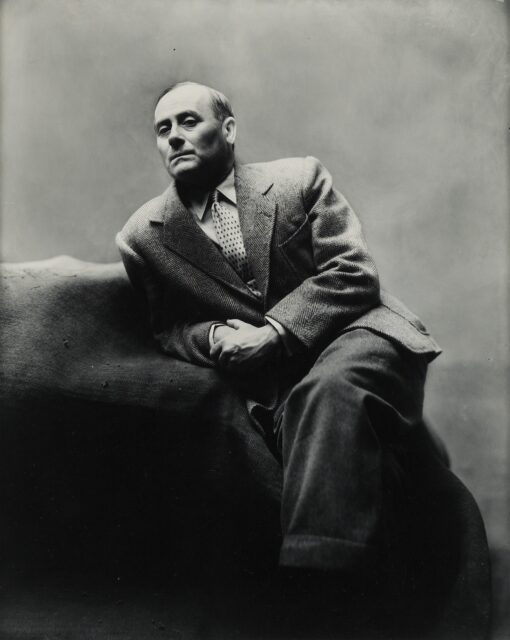
Irving Penn, courtesy The Art Story.

Lisa Fonssagrives,
Swedish model and dancer, who was married to Penn. Courtesy Robert Klein Gallery, on display at DeYoung.

Still life with food. courtesy DeYoung.

Picasso, courtesy DeYoung.
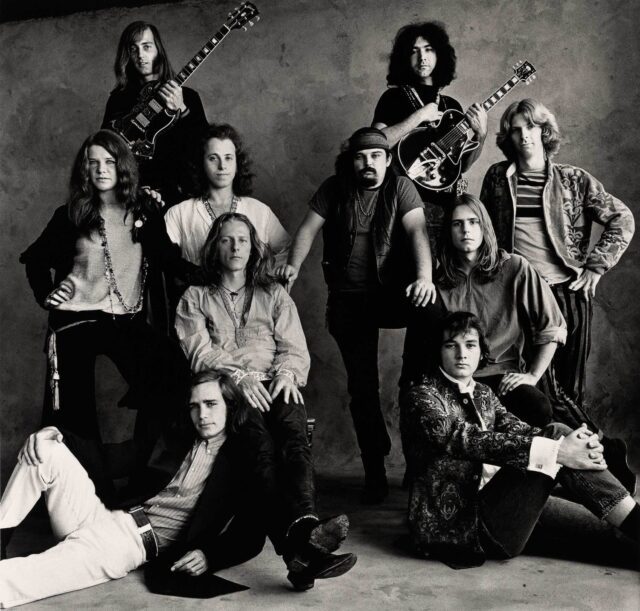
Rock-Groups,Big-Brother and the Holding-Company and Th Grateful Dead San-Francisco. Courtesy DeYoung.

Audrey Hepburn, image courtesy The Penn Foundation, on display at DeYoung.
The exhibition includes approximately 175 photographs, spanning every period of Penn’s career. Works in the exhibition range from his early documentary scenes and celebrity portrait (including Audrey Hepburn, Marlene Dietrich, boxer Joe Louis), to workers posing with the tools of their trades, abstract nudes and fashion studies. A special section features San Francisco’s Summer of Love from 1967: hippies, members of the Hells Angels Motorcycle Club, and local rock bands such as the Grateful Dead and Big Brother and the Holding Company.
Of note, Penn would set up the same gray backdrop to shoot Hells Angels bikers, dropouts, and acid freakout rockers as he would soignée models in haute couture. In fact, Mr. Penn, as his Vogue colleagues knew him, would shoot some of his portraits — the series of the tradespeople of Paris for instance — while waiting for his models to show up.
“Innovating across photographic genres throughout his extraordinarily long career, Irving Penn is one of the giants of 20th-century photography,” said Thomas P. Campbell, director and CEO of San Francisco’s Fine Arts Museums. “Nothing ever escaped Mr. Penn’s eye—or his lens.”
According to Anna Wintour, editor-in-chief of Vogue, Irving Penn “changed the way people saw the world and our perception of what is beautiful.”
Frank Stella:
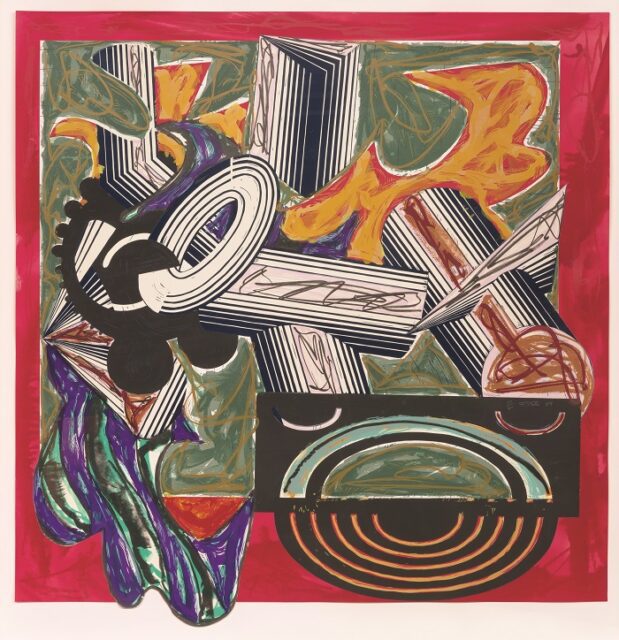
“Frank Stella: Had Gadya” — Then came a dog and bit the cat, 1984.
© Frank Stella / Artists Rights Society (ARS), New York
Frank Stella, the American art world giant, who moved from proto-minimalism to extreme abstraction, recently died at age 87. The artist, famously closed-mouth about his work conceded only this about his work: “What you see is what you see.”
In 1959, Stella gained early and immediate recognition for his series of coolly impersonal black striped paintings that turned the gestural brushwork and existential angst of Abstract Expressionism upside down. The groundbreaking work pushed the boundaries of post-war modern art and abstraction.
Focusing on the formal elements of art-making – art for art’s sake – Stella went on to create increasingly complicated images.
Baroque period artists such as the early-17th-century Italian painter and super star, (then as now), Caravaggio developed illusionistic “tricks” that suggested his subjects emerged out of the canvas and into the viewer’s space. Stella was influenced by that very bad boy and celebrity, taking Caravaggio’s notion of innovation a step further by literally extending art into the third dimension in painterly reliefs, which entered the viewer’s space, incorporating protruding materials.
Stella ultimately went on to create large-scale, freestanding sculptures, architectural forms, and the most complex work ever realized in the medium of printmaking. Complex work that was flamboyantly vibrant.
Discover the power and innovation of Stella’s art and Jewish storytelling in “Had Gadya.” The exhibition featuring 12 prints, inspired by a series of lithographs by El Lissitzky,(1890-1941), a colorful series of lithographs by the Russian Jewish modern artist that illustrate the verses of “Had Gadya,” created over half a century earlier.
“Had Gadya” (“One Little Goat”) is an Aramaic/Hebrew song traditionally sung to conclude the Passover Seder, the ritual meal of the Passover holiday. The song tells the tale of cyclical violence and its end through divine redemption: a baby goat is eaten by a cat, who is bitten by a dog, who is beaten by a stick and so on. Each subsequent verse builds on the story, with aggressors becoming victims themselves; finally, the cycle is broken with God’s intervention.
The song has been interpreted in many ways over the centuries; a common interpretation casts it as a metaphor for the chain of persecution that has targeted Jewish people since antiquity.
According to the Skirball, the striking visuals of “Had Gadya,” together with audio interpretation and associated text, shine a light on the various interpretations of the song’s lyrics and provide an opportunity for learning about and reimagining Passover traditions. The cross-cultural and intergenerational aspect of this exhibition reveals the profound impact of Jewish artists and culture on the broader American cultural landscape at a time we all need reminding.
“Wild Things Are Happening: The Art Of Maurice Sendak”:
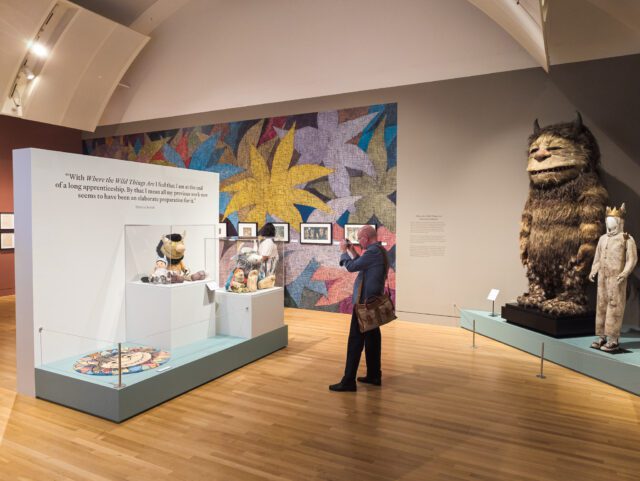
Wild Things, art of Maurice Sendak, courtesy Skirball.
The Skirball show provides proof positive of the fact that Maurice Sendak was a very prolific artist. Even those who know his work well will be stunned by its sheer scope and volume.
Sendak is best known as illustrator/author of children’s books. Iconic images from “Where the Wild Things Are” — Max, the boy in a wolf costume traipsing through the wilderness with giant chimerical monsters — are indelibly etched into the minds of millions. In fact, one of the highlights of the exhibit is the wolf costume worn by Max Records in the 2009 film, displayed alongside one of the large monsters created by Jim Henson’s Creature Shop.
However, Sendak’s art is not relegated to two dimensions: A clock from a production of Nutcracker (1983) during his days as an opera designer; a stage model for the Chicago Opera Theater’s Brundlibar (2003); stuffed animals and a machine-hooked rug, both inspired by “Wild Things”; a prototype of a Mother Hubbard toy developed by Sendak and his brother, Jack; and a Mickey Mouse bagatelle game— underline the fact that Sendak approached all media with childlike, joyful curiosity.
“I don’t set out to do books for children,” said Sendak in a 2003 interview with art historian Jonathan Weinberg. “I don’t know how to do that. I don’t think anybody knows how to do that.”
But behind those words is a singular truth about artists, one Picasso once underlined: children know more than adults generally give them credit for. And – per Pablo – the ideal vision for an artist is a child’s vision.
“People keep things from children now,” Sendak said, “in the sense that we don’t want to frighten them or upset them, yet we all know they sat and watched the [World Trade Center] towers go down a hundred thousand times. They’re just waiting for you to tell them.”
“Wild Things Are Happening: The Art Of Maurice Sendak,” comprised of over 150 artifacts—including original paintings, drawings, videos, and objects— showcases the depth and breadth of the artist/writer’s boundless creativity.
“Wild Things Are Happening: The Art Of Maurice Sendak” moves to the Denver Art Museum after 9/1.
Now, with apologies to Hilary Mantel, let’s bring up the bodies.
Mountain View Cemetery, Oakland:

Image courtesy Discover Dunwoody.
Luminaries at the Mountain View Cemetery in Oakland include Henry J. Kaiser, 1882 – 1967, builder of the Hoover, Bonneville and Grand Coulee Dams, WWII Liberty ships and founder of the Kaiser Permanence Health Plan. Also Warren Bechtel, 1872 – 1933, founder of the Bechtel Corporation. T.A. Soong, 1907 – 1969, a Chinese-American banker and brother of Madam Sun Yai-Sen and Madam Chiang Kai-shek. And so on. Also author Frank Norris, artist Thomas Hill, architects Julia Morgan and Bernard Maybeck, captains of industry such as powerful railroad builder and banker Charles Crocker…
They all made their contributions to the shaping of our nation’s frontier.
But it is not those resting in peace under ground that makes Mountain View a worthwhile stop. It is the grounds themselves, the 226-acres were designed by Frederick Law Olmsted, the renowned landscape architect of New York City’s Central Park; the Capitol Grounds in Washington D.C.; Stanford University; and Yosemite Park, where Olmstead minimized the intrusion of man on its natural wonders.
According to historians, park-like cemeteries such as Mountain View were the sum of various cultural forces of the 19th century. In its design, Olmstead drew on a popular philosophy of the times, American Transcendentalism, to help shape his vision for this elaborate final resting place. American Transcendentalism embodied Asian philosophy, which argues that all nature flows from the same wellspring, that is, trees and flowers, water and air — and man — are all the progeny of Mother Nature.
From that lofty notion, Olmsted believed the straight line of man’s industry and the curved shape of nature’s oak branches could once again peacefully co-exist.
Historians agree that Mountain View Cemetery captures the fabled Gardens of Eden and Gethsemane, Parisian sophistication, English culture and American spirit.
So visit to see the various mausoleums and places of worship on the site, but really make the stop for the hiking and spectacular views.
And while in Oakland, consider a visit to Michael’s for chocolates and/or great ice cream.
Montalvo Arts Center, Saratoga:
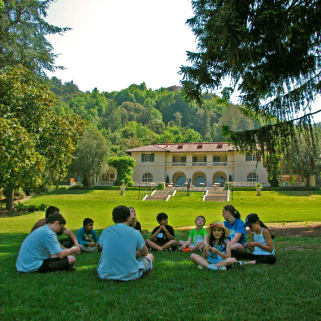
Montavlo, courtesy the estate.
Montalvo Arts Center is a non-profit cultural and arts center, a park, hiking trails and the historic Villa Montalvo, an Italian Mediterranean Revival mansion in the foothills of the Santa Cruz Mountains.
Villa Montalvo is a national historical landmark designed by William Curlett, as lead architect. Upon Curlett’s death, his son, Alex Curlett, and partner, Charles Gottschalk, took over the completion of the venue. The villa’s gardens and grounds were designed by John McLaren, the landscape designer of Golden Gate Park, who laid out the grounds with hidden nooks and wisteria-covered pergolas.
Villa Montalvo was built for James Duval Phelan (1861-1930), a three-term mayor of San Francisco. The man went on to become California’s first popularly-elected U.S. Senator, was remembered as a patron of the arts and an advocate for public health, women’s suffrage, and anti-corruption. Phelan is responsible for creating public parks and protected natural spaces, also for the damming of Hetch Hetchy Valley, a key water source for the San Francisco Bay Area for over a century.
However, Phelan is also remembered for his nativist and racist politics—especially his career-long endorsement of Asian exclusion acts and his opposition to Asian immigration.
Villa Montalvo was his beloved country home until his death in 1930. Today the complex strongly disavows its owner’s politics, instead focusing the breathtaking landscape and the cultural programming that happens inside its beautiful grounds.
Filoli:

Filloli, courtesy the foundation.
The vibrant landscape of Filoli in the Bay Area is situated on the unceded ancestral lands of the Ramaytush Ohlone, in Woodside, California. The estate boasts 654 plant-filled acres nestled along the slopes of California’s coastal range.
Filoli was originally built as a private residence in 1917 and opened to the public in 1975 as a 501(c)(3) nonprofit and site of the National Trust for Historic Preservation. The property is considered one of the finest remaining country estates of the 20th century.
Filoli features a 54,000+ square-foot Georgian revival-style mansion, 16 acres of exquisite English Renaissance gardens, a 6.8-acre gentleman’s orchard, and 100s of acres of natural lands with five distinct ecosystems and a one-mile estate trail.
We found the interior interesting, as in damning with faint praise. However, those beautiful gardens, especially the veggie gardens, are well worth a visit.


Sorry, the comment form is closed at this time.